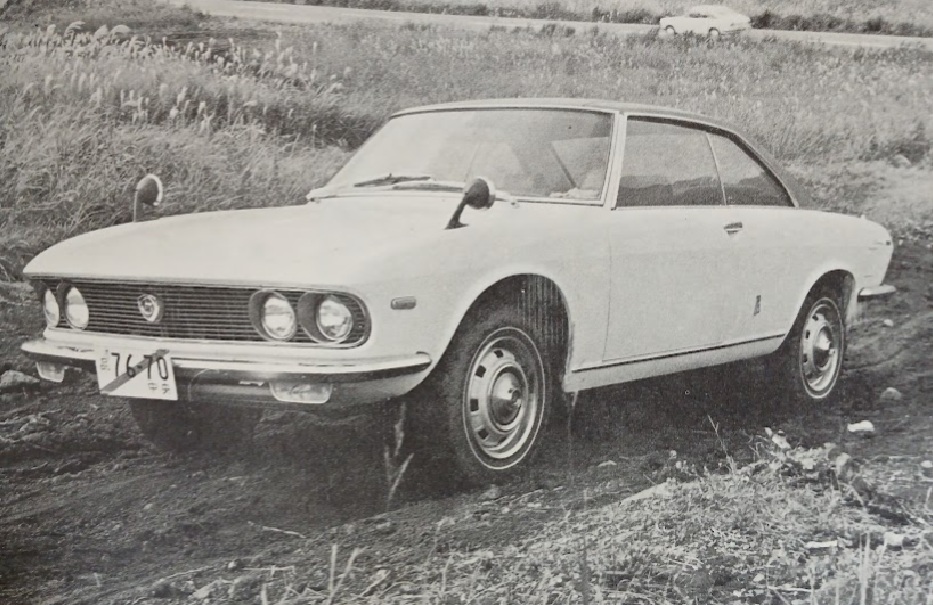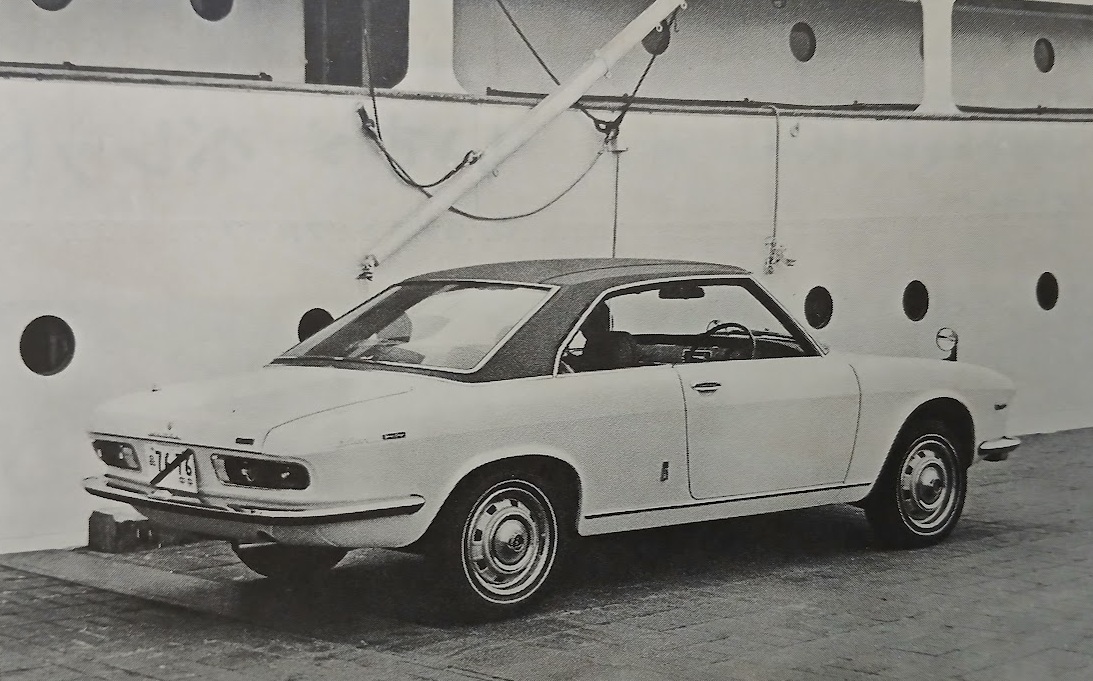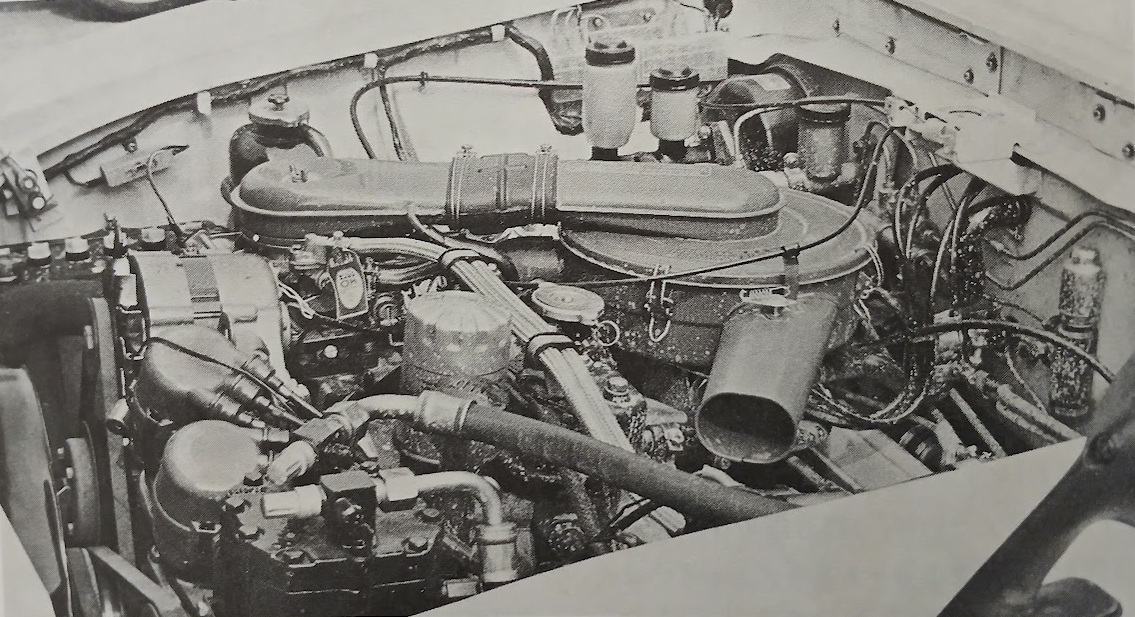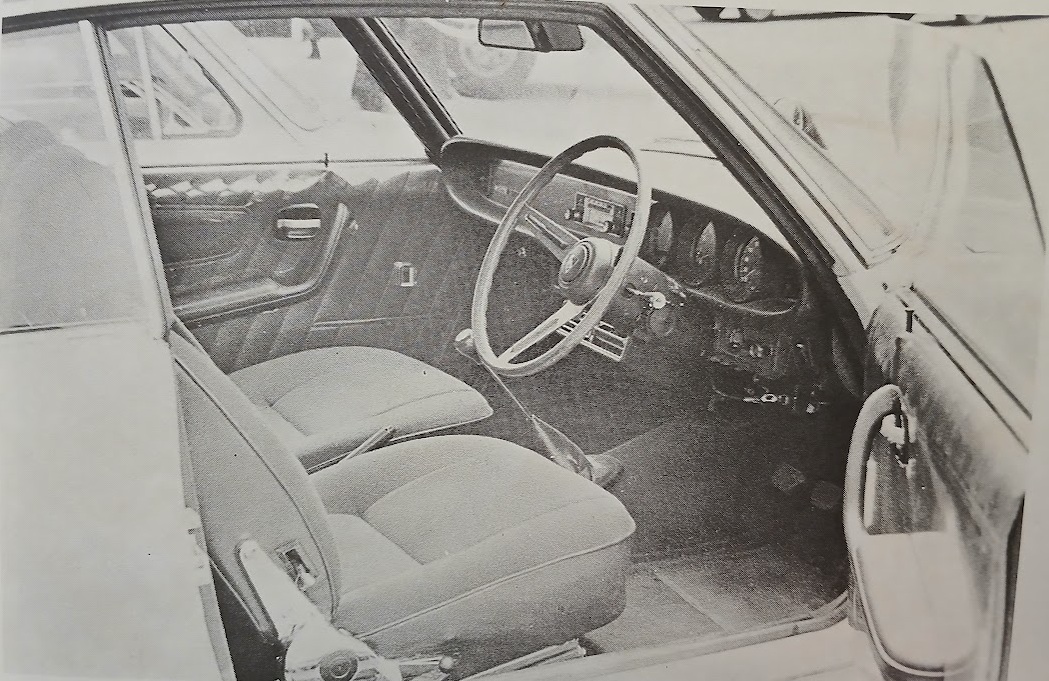Mazda Luce Rotary Coupe (1969)

Publication: Car Graphic
Format: Road Impressions
Date: December 1969
Author: Shotaro Kobayashi
Road testing the Luce Rotary Coupe
The third prong of Mazda’s “rotaryization” strategy, the Luce Rotary Coupe, was finally released on October 15th. Prior to its announcement to the general public, a test drive was held for the press, going from Tokyo to Hakone and back. This C/G editor, who has now recovered from his leg injury, also participated, so I would like to share my brief impressions.
Before that, let’s take a look at the specs of this car. As its name suggests, the Luce Rotary Coupe is a front-wheel-drive car with a rotary engine. Although it is named “Luce,” there are almost no mechanical similarities between the sedan and the coupe, except for some body presses. First of all, the size is larger than the sedan. It is quite long for a domestic car. The wheelbase is 80mm longer than the sedan, and the overall length is 215mm longer, roughly equivalent to the Crown Hardtop. The vehicle weight is also 200kg heavier than the Luce 1800, at 1255kg (in Super Deluxe trim).
The engine is a 655cc x 2 rotor 13B type, slightly larger than the 491cc x 2 10A of the Cosmo and Familia Rotary. As an international practice, when comparing a rotary with a reciprocating engine directly, the displacement is doubled. In the case of the Luce, this should be equivalent to 2.6 liters, but in the Japanese tax system, an illogical (political?) element of “vehicle class” comes into play, and the car is assigned a 5-number plate.
The engine is basically the same as that of the Familia Rotary series, with the side housing made of special cast iron (the Cosmo’s is made of light alloy), and the increase in displacement is achieved by enlarging the trochoid shape. This was not accomplished by increasing the thickness of the rotor housing (though this would have been more economical in terms of production costs), but was due to the necessity of shortening the engine length as much as possible, making it possible to overhang the front axle, and drive the front wheels. The intake and exhaust system is a side inlet, peripheral exhaust port type, a tradition of Toyo Kogyo since the Cosmo, and is designed with a particular emphasis on low and mid-range torque to suit the driving conditions in Japan. (NSU’s R080 and Mercedes’ prototype C111 use peripheral ports and focus on high-speed performance). The differences from the existing Familia and Cosmo series are that the oil pump is driven by a quieter chain, and the oil cooler is water-cooled and fixed to the top of the engine (eliminating the need for oil hoses).
The powertrain layout is fundamentally the same as that of the NSU Ro80, with the engine suspended forward of the front axle, followed by the differential and four-speed gearbox. Both the inner and outer driveshafts are Burfield-type constant velocity joints, with the inner one being slightly expandable in the axial direction, eliminating the need for an unpleasant sliding joint (especially so in powerful cars).
Radial tires are standard, measuring 165HR-15, which is unusually large for a modern passenger car.
Naturally, the suspension is completely different from that of the Luce sedan, being independent at all four wheels. The front suspension is of the double-wishbone type, but what is unique about it is that it uses rubber-in-torsion springs. It is well-known that Toyo Kogyo has been using this type of spring for many years in its R360 Coupes and Carols. The reason they used it on the Luce Coupe in particular was to block out noise from the road surface, which was an especially serious concern since the Luce Coupe comes standard with radial tires, as mentioned above. The rear suspension is independent with semi-trailing arms, and the springs, which were rubber-in-torsion up to the car exhibited at last year’s Motor Show, have been changed to coil springs on the production model.
The front brakes are Bendix Akebono discs (with a large 274mm diameter) with vacuum servos, and the rears are leading/trailing shoe drums with a proportioning valve to prevent premature locking. The rear brakes are automatically adjusted every time the handbrake is applied.
The steering is also different from the Luce sedan, being rack-and-pinion with a shock absorbing mechanism on the shaft. Power steering is standard on the Super Deluxe model, with a reduction ratio of approximately 19:1 (22:1 on the non-powered Deluxe model).
Although the body retains the familial image of the Luce sedan, it has a completely new design, with a semi-monocoque structure that has been strengthened especially in the lower structure due to the hardtop roof with no center pillar. As mentioned, the car’s weight is 1255kg (in Super Deluxe trim), more than 200kg heavier than the Luce 1800, and this is because it has more elaborate soundproofing and sound insulation treatment, and is equipped with accessories such as power equipment and air conditioning.
The smoothness and quietness of the rotary engine has already been mentioned many times during the testing of the Cosmo and Familia, but with the help of excellent soundproofing, the Luce Rotary’s engine is even quieter and more refined. Its flexibility at low speeds is far superior to that of a reciprocating engine with the same high-speed performance, and it can pull away smoothly from just 1000rpm in second gear. Even at low speeds, it can start off without much revving, and in top gear it accelerates easily from under 40km/h, so there is no need for frequent gear changes and it is very easy to drive in the city. However, the car really comes into its own once you get on the open highway. The rev counter, located in a prominent position in the instrument cluster, is in the yellow zone from 6000-6500rpm, but the engine can rev up to 7500rpm or more (at this point a buzzer sounds to warn of over-revving) without any mechanical stress.
The gear ratios are well matched to the power and weight of the car, so that when revved up to 6000rpm, the speeds reach about 50, 90, and 140km/h in first, second, and third gears, respectively. 100km/h corresponds to about 3300rpm in fourth, and at this speed the engine hums softly, there is no vibration, and with the windows closed you can whisper to the person next to you. The indirect transmission is always quiet, even in top gear, there is no obvious peak in the torque curve, and the car will always follow your lead when you step on the gas over a very wide range of rpm. In the past, Rolls-Bentley used the catchphrase, “silent sports car,” but the Luce Rotary Coupe is truly worthy of the term “Silent Sports Coupe.”
140km/h is a practical, comfortable cruising speed if the law allows. Because it is so quiet and smooth, the Luce Rotary Coupe doesn’t feel that fast, but in fact it is quite quick, accelerating from 0-400m in 17.1 seconds. The engine is so powerful that even on dry roads, and even with the 165HR-15 tires’ good grip on the pavement, the front wheels can easily spin from a start if you step on the gas a little too enthusiastically.
The power is transmitted extremely smoothly, and there is no snatch even when accelerating or decelerating suddenly, which is particularly noteworthy for such a powerful front-wheel-drive vehicle. One characteristic of the rotary engine is that when you release the accelerator pedal, there is almost no engine braking, as if the engine is freewheeling, which feels strange, at least at first.
The servo-equipped disc/drum brakes are simply superb. The pedal effort is light and the front-to-rear braking force is distributed precisely (with the help of the proportioning valve), so even when braking suddenly, all four wheels are gradually and surely slowed. Another plus is that despite the soft suspension, there is very little nose dive.
The car I took to Hakone was a Super Deluxe, equipped with power steering as standard. Considering that this is a front-wheel-drive vehicle with 800kg on the front wheels even the car is unladen, and that the tires are 165HR-15 with a wide contact patch, I understand why they put power steering on it, but to be honest, the power steering spoils a lot of the enjoyment of what is basically a good car. First of all, it’s incredibly light. In fact, it’s excessively light. Being light in itself is not necessarily a bad thing, but it’s a problem when it completely takes away the driver’s sense of the road surface, and that’s exactly what’s happening in the Luce Rotary Coupe. It’s particularly oversensitive when going straight, and it can be easy to turn the wheel too much. It’s not much of a problem at low speeds, and you really appreciate the power assist when driving around town or parking, but it would be better not to have it at high speeds. Even at relatively low speeds, around 100km/h, you need to concentrate on the steering when changing lanes. On days with strong crosswinds (as was the case on the test day), even a front-wheel-drive car with good directional stability will be pushed around a little, and it is exhausting to have to pay so much attention to the oversensitive steering.
Later, I tried driving a Luce Rotary Coupe without power steering, and its steering was not too heavy around town (about the same as a Crown Hardtop SL’s), and the castor action was just right, making it even more difficult to understand the purpose of the power steering. Incidentally, without power assist, the steering ratio is slightly slower, but with 3.8 turns from lock to lock, it is still not particularly busy, and the turning radius is only 5.3m (surprisingly small for a front-wheel-drive car with a long wheelbase). I am not necessarily opposed to power steering itself (the systems on the Mercedes and Ro80 are very good), but in the Luce is difficult to accept in its current state. I would like to encourage the manufacturer to reconsider its design.
The ride is solid, befitting a luxury coupe, and the thick, good-sized seats make it extremely comfortable. In preparation for the use of radial tires, the suspension uses a lot of rubber insulation, which effectively eliminates road noise. The handling is excellent, except for the shortcomings of the power steering. Despite being a quite heavy and powerful front-wheel-drive car, understeer is kept to a moderate level, and there is very little change in posture whether the power is on or off. As already mentioned, roll is mild for a soft suspension, and there is very little nose dive. In short, the Luce Rotary Coupe successfully overcomes the shortcomings of front-wheel-drive and highlights its advantages.
Next, regarding fuel economy, which is a well-known weak point of rotary engines, the average fuel economy on the day trip from Tokyo to Hakone via the Otome Pass on the Tomei Expressway was 6.7km/l (on regular fuel). This is by no means good, but for the owner of a 1.75 million yen car, a little gasoline consumption is probably not a big problem.
The interior is luxurious but unified in modest good taste. Naturally, priority is given to the front seats in terms of space, and the reclining seats allow even tall or overweight drivers to find their preferred seating position. However, due to the thick backrests with headrests, the rear seats are considerably tighter than in the Luce sedan, and it is difficult to say that either headroom or legroom are sufficient. The front seat floor has a transmission hump, just like in a rear-wheel-drive car, but the rear seat floor is, as expected, almost flat. Convenience equipment such as power windows, air conditioning, powerful ventilators, and a rear window defogger add to the luxury appeal of this “Traction Avant” coupe, which costs 1.75 million yen.
Postscript: Story Photos


